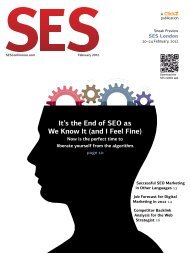Create successful ePaper yourself
Turn your PDF publications into a flip-book with our unique Google optimized e-Paper software.
focus MarketingAutomationStart Winning Now with AdWords EnhancementsUse Marketing Automation and Mobile Targeting to Ensure the Success of Your Advertisingby David SzetelaGoogle AdWords managers, are youfeeling overwhelmed lately? Youhave every reason to be. Duringthe past 12 months, we’ve seen therollout of more major AdWords features andoptions than in any similar period. Let’s takea look at two categories of changes—marketingautomation and mobile targeting—andsee how you can profit from them.Business Intelligence andMarketing AutomationOf all the tasks on the PPC manager’s to-do list,managing bid prices is one of the most complicatedand time consuming. Enhanced Campaignsfeature the ability to set bids preciselyby compounding bid modifiers. For example,you can boost keyword bids by 50% when adsare served to people in a particular location,and another 75% if those same people are performinga search on a mobile device.The good news is that this helps ensurethat your ads are seen by the right person, atthe right time, and in the right location. Thebad news is that performance reporting, dataanalysis, and bid adjustment can becomemuch more difficult.More good news / bad news: you can nowsee Google Analytics data in the AdWordsuser interface. Data points like bounce rates,page views, and even multi-channel funnelassists are available at the campaign, adgroup, ad, and even keyword level. PPC managersapplaud this trend; after all, better datatransparency means better control, right?Not always. As the number of availabledata points increases, so does the timerequired to analyze the data and take action.How can you manage keyword-level biddingfor a 50,000-keyword account if there are 10juicy data points per keyword to take intoconsideration?Enter automated bid management.Built into AdWords are three types of bidautomation: Enhanced CPC Bidding, Con<strong>version</strong>Optimizer, and Display CampaignOptimizer (for display campaigns only andrecently renamed Automatic CampaignOptimization.) All three act on performancedata that Google “knows” about every keywordand site placement ever used in its network.These bid management features aren’tperfect, but they’re free. More to the point,they save management time and, especiallyfor accounts with lots of keywords, do amuch better job at monitoring and optimizingkeyword bids than a human ever could.The proliferation of data points, targetingmethods, and compounded bid adjustmentoptions will increasingly drive AdWordsadvertisers to take advantage of bid automation,whether supplied by Google or by athird-party vendor like Acquisio, Kenshoo, orMarin. These third-party platforms can factorin the cost and effect of previous marketingactions (like consecutive visits to an advertiser’ssite), something that Google’s bidautomation tools can’t do—yet. But Googlehas taken one step in that direction with theprovision of Multi-Channel Funnel data inAdWords, and they’ve also announced thatthey will soon give advertisers the ability totrack offline-to-online and online-to-offlinecon<strong>version</strong>s.For example, the recently announcedGoogle Offers Extension allows an advertiserto include in their ad a link to an offer—e.g.,a discount coupon—that can be redeemed ata physical location. Google provides mechanismsfor tracking the redemption of theseoffline offers.So I think we’re just a few years away fromthe advent of true marketing automation—the tracking of a customer’s behavior no matterwhat advertising medium they’ve beenexposed to. We might even see Google carryout experiments of the past—print, radio, andTV advertising bought on a cost-per-actionbasis. Those efforts weren’t so much failuresas they were ahead of their time.Mobile Is the New PCAccording to the Gartner Group, shipmentsof desktop PCs have been declining steadilysince 2004, and mobile PC shipments havebeen dropping since their peak in 2010.Meanwhile, tablet and smartphone computershipments are, according to IDC, experiencingdouble-digit growth, and by 2012 hadachieved a combined 65% market share comparedto desktop and notebook PCs.Little wonder that Google is using theEnhanced Campaign context to encourageadvertisers to target tablets and smartphones.To put it bluntly, if your ads are onlytargeting traditional PCs, you’re appealing toa dwindling audience.Google’s recent emphasis on mobileadvertising isn’t exclusively self-serving.The company wants to ensure an optimaluser experience for searchers, and wants itsadvertisers to profit from the trend towardmobile device adoption. Here are some waysto ensure your mobile advertising success:••Use responsive design principles to givesite visitors a positive experience nomatter what device they’re using.••Think about creating an app rather thanforcing your customers to interact viaa traditional site. People using mobiledevices are more comfortable with agesture-based user interface than witha keyboard-and-mouse interface.••Watch the developments in the “mobilepayments” space. E-retailers likeAmazon and services like Google Playand the Apple App Store have beensuccessful on mobile devices becausethey offer fast, easy, one-click buyingmechanisms. When all e-retailers canoffer similar mechanisms, sales viasmartphones and tablets will skyrocket.••Offer potential customers a phone-onlyoption for contacting you, and useAdWords Call Extensions to make iteasy for smartphone users to call.Online advertising expert DavidSzetela is the former Ownerand CEO of Clix Marketing, aPPC advertising agency.12 <strong>SES</strong> • March 2013 {New York}




